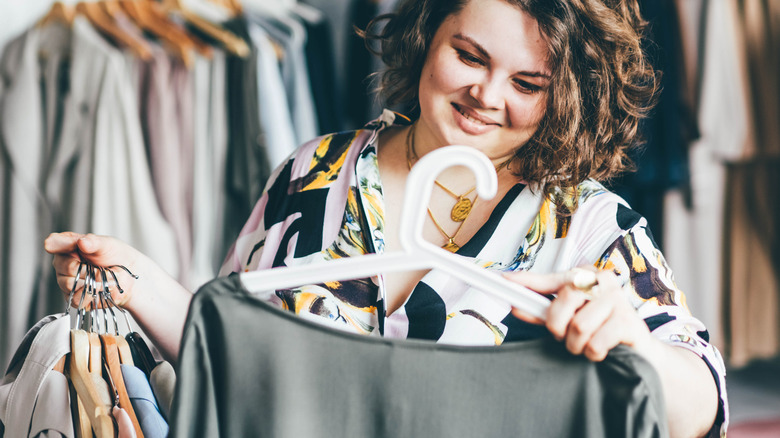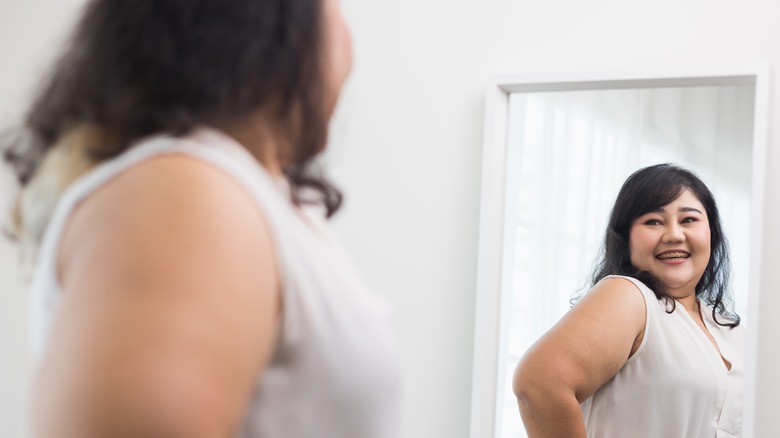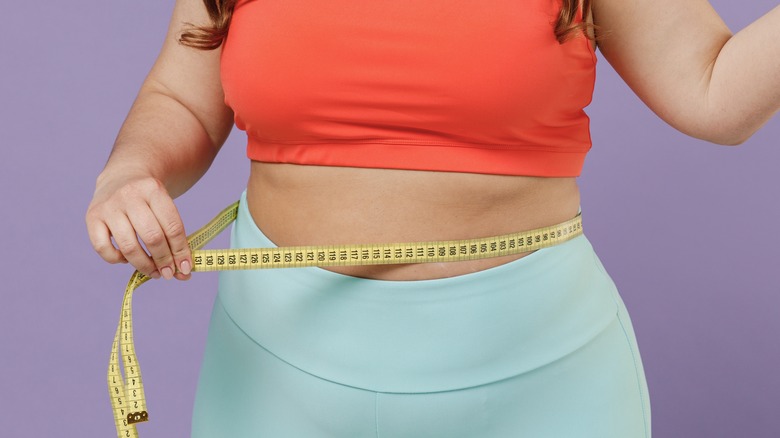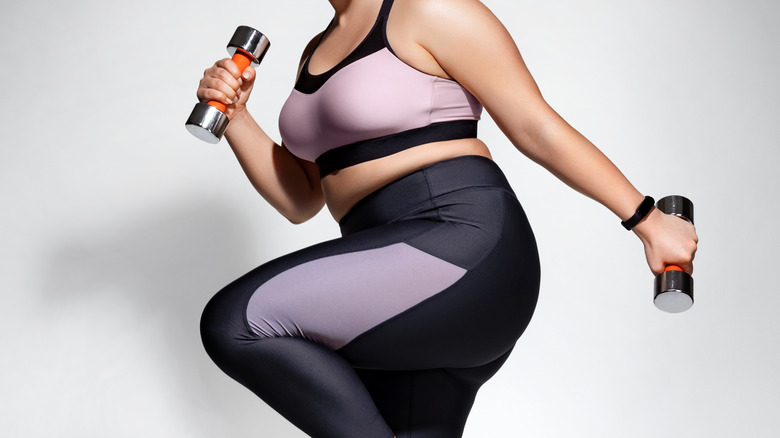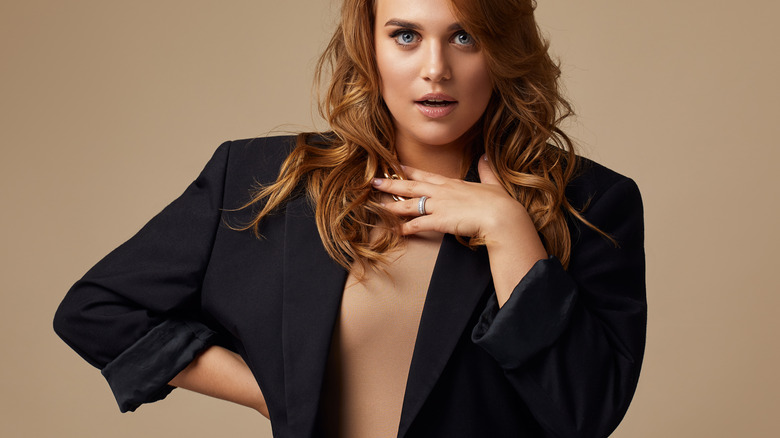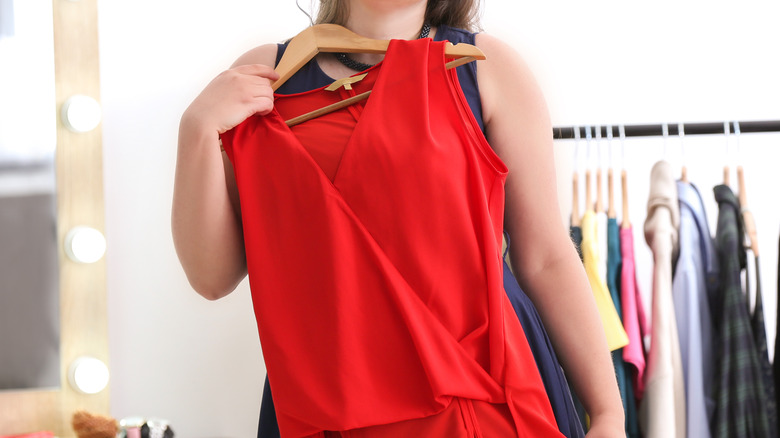5 Tips For A Better Thrifting Experience When You're Plus-Sized
Figure-wise, over 13 million women, or 12.7% of the total U.S population were considered stout, per a 2013 study in the Clothing and Textiles Research Journal. In the 1920s, the term "stout" was used to portray a female with bust, back, and hip curves that did not conform to the common criteria of the ideal female figure. According to Fashionizers, the term "plus-size" first appeared in a Lane Bryant ad in the late 1920s but didn't become widely used until two decades later. Although the fashion industry has been more inclusive in the last decade, the bulk of ready-to-wear designs continues to be smaller-sized garments. As a result, when purchasing mass-produced togs, curvier women must frequently have their outfits adjusted or shed some pounds to fit in.
Plus-sized clothing is generally defined as sizes 18 and above, also known as XL, or sizes 1X to 6X. Sizes 7X and beyond are considered extended-size clothing. With the plethora of plus-size boutiques available nowadays, finding on-trend clothes is no longer a struggle for large-bodied ladies. However, many full-figured customers are still lacking options at thrift stores — treasure troves of unique, pre-loved designs sold at dirt cheap prices. If you've been in that situation, take heart! Lack of accessibility to thrift store wardrobes when you have a larger body doesn't mean you have to be on the margin of thrifting. If you're on a treasure hunt for plus-size clothing sold at affordable prices, here are some tips that might stand you in good stead.
Turn a blind eye to sizing, try the stuff on
Turns out, size shouldn't matter that much when it comes to shopping. The thing with size signs in the U.S and the U.K is that even though size standards exist, many manufacturers and fashion marketers don't use them anymore. What you're seeing on the racks in many stores these days are results of vanity sizing, which is the practice of labeling ready-to-made clothing with a size smaller than they really are, per a 2012 study in the Journal of Consumer Psychology. The goal of this practice is to fulfill wearers' wishes of feeling "thin" and, above all, to promote sales. For instance, a bust size of 32 inches was a size 8 in Sears's 1967 catalog. In the 2011 catalog, this same bust size became a size 0. Simply put, size inconsistency is prevalent, and you shouldn't take size signs at face values.
Another thing that many people ignore is that fabric materials, especially the amount of stretch in the fabric, also play into the fit of an outfit, Alison Hoenes Design points out. Pre-loved clothes, after a few wearings or many rounds of spinning and tumbling during laundry, might also stretch and become loose. Sizing is not universal, and you should take it with a grain of salt. The best way to know if you fit into a garment is to bring it into a fitting room and try it on.
Have your measurements down pat
Memorizing your measurements or having them saved on your phone will make your shopping experience more effective, whether you're thrifting offline, buying clothes online, or getting a garment tailored, Lands' End advises. To take your body measurements, wrap a measuring tape moderately taut around the widest parts of your chest, waist, hips, shoulders, upper legs, and inseam. Once you've got all your measurements laid out, use them to find your body shape so that you know how to find garments that highlight your best features.
According to Armoire, some common categories for describing different body shapes include the oval shape, the inverted triangle, the triangle, the rectangle, and the hourglass. A person with an oval shape is someone whose waist is wider than their bust and hips. An inverted triangle is a metaphorical description of someone with broad shoulders and narrow hips. If your hips are the widest part of your body, your body shape is a triangle, otherwise known as a pear shape. In case your bust is about the same width as your hips, you have a rectangle body shape. For a body to take on an hourglass shape, it must have a slim waist, as well as a breast and hips that are about equally broad.
Prioritize stretchable clothes
If you're into fitted clothing, prioritize those that offer extra stretch combined with a lightweight feel. Stretchable clothing flatters a range of sizes apart from heights, making you look stylish while feeling comfy. The stretch fabric "allows you to move unrestricted," says fitness influencer Chasi Jernigan to The Strategist. Most stretch fabrics have a proportion of elastic fibers woven into the threads for stretchability. This elastic element is also known as Lycra, spandex, or elastane, which are different names used for the same material. Fabric types that expand to a great length include stretch cotton poplin, spandex jersey, neoprene rubber, and stretch lace. Embroidered mesh, lace, polyester, chiffon, twinkle satin, cotton, and silk, are among fabric types that don't stretch.
Comfortability aside, clothes made from stretch woven fabrics have a reputation for their durability, Olivers points out. And durability is what helps your clothes weather all sorts of elements, like stains, weight gain, and wear and tear. If your clothes have limited stretchability, you can stretch them manually. One way to do so is to soak your clothes in cold water for 24 hours and when they're soaking wet, hang them outside for a few days. When your garments are dry, they should be about one size larger. If not, repeat the soaking and air-drying process.
Look into the men's section
Men are generally more big-boned than women, which is why most of their sizes are larger than women's. If you have trouble finding good-looking clothes that fit you, why not shop at the men's section for more styling possibilities? A majority of designs in menswear racks are similar to those in the womenswear section but in bigger sizes. For instance, you can never go wrong with an XXL blazer, an indispensable item in Hailey Bieber's signature look. The longer hem of a men's blazer, according to My Chic Obsession, can create the form of a blazer dress and help you pull off a modern It girl look.
A broad-shouldered, wide-collared men's shirt is also a compelling cost-per-wear item that offers fertile styling possibilities. One way to wear a men's shirt, per stylist Katie Eastwood (via Woman & Home), is to "wear it as a light layer." You can wear it unbuttoned over a top and jeans or as a shirt dress if it has an elongated form. To add a soft touch to your ensemble, you can pair your menswear items with sexy leggings, a feminine skirt, or a girly headband. Oversized clothing is more ventilated and comfortable than fitted clothing while exuding a sense of smart — casual confidence.
Come up with a list of your go-to places for thrifting
To save you time and energy sifting through countless hangers or altering your finds after each purchase, Cosmopolitan recommends following shops and sellers that offer specific types of clothes within the kind of price range that suits you. Most thrift stores have their unique selling points. For example, some thrift shops specialize in retro-inspired, exclusive t-shirts, while some offer funky, many-hued articles of clothing that can help you reinvent your wardrobe.
For the most up-to-date or once-of-a-kind finds, you'll have to visit more upscale thrift shops, where prices can run a few hundred bucks. If you know which thrift shops sell the type of looks that you're going for, your hunt for the most stylish goodies will be fruitful. Although you can always order hand-me-down stuff online once you know your measurements, The Everygirl recommends visiting physical stores to ensure what you buy is what fits you.
